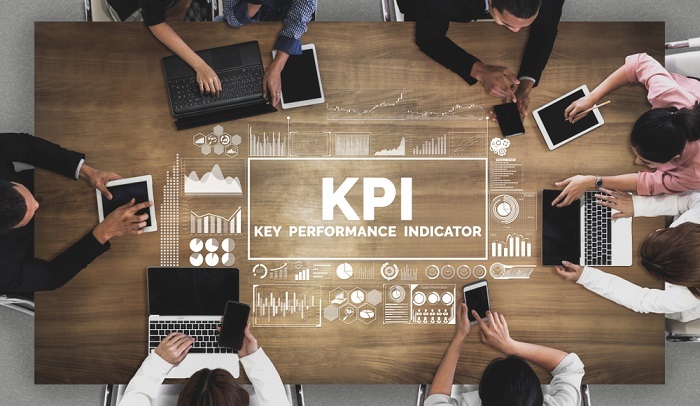
 Data Structure
Data Structure Networking
Networking RDBMS
RDBMS Operating System
Operating System Java
Java MS Excel
MS Excel iOS
iOS HTML
HTML CSS
CSS Android
Android Python
Python C Programming
C Programming C++
C++ C#
C# MongoDB
MongoDB MySQL
MySQL Javascript
Javascript PHP
PHP
- Selected Reading
- UPSC IAS Exams Notes
- Developer's Best Practices
- Questions and Answers
- Effective Resume Writing
- HR Interview Questions
- Computer Glossary
- Who is Who
What Type of Information Can KPIs Provide?
KPIs are performance indicators that measure the progress of an organization over time. They are used to set goals and gauge the effectiveness of an organization's operations. They help guide decision-making by allowing teams to identify areas of weakness and strength and make data-driven decisions.

KPI stands for a key performance indicator. It is a measure of how successful an organization or individual is at reaching its objectives.
Key performance indicators can be presented to a specific person or department, or they can be presented to the entire organization. High-level KPIs are usually focused on the company's overall performance, such as achieving $1 million in recurring revenue. On the other hand, low-level ones are those that are focused on specific processes or teams.
What Makes a Good KPI?
Good metrics are simple to measure and can be used to improve a company's performance. There are a few tips that you can use to set effective KPIs.
KPIs should align with the company's overall strategy and objectives. For instance, if your goal is to increase the monthly recurring revenue of your company by 20%, then your objective should be aligned with the business strategy. Having a high-level KPI can help you achieve this goal, while having a low-level one can help you improve the efficiency of your sales team.
One of the most important factors that you should consider when it comes to setting effective KPIs is having a plan in place to reach them. This will allow you to make informed decisions and improve the efficiency of your organization. Having a plan will allow you to reach your goals and improve the effectiveness of your marketing efforts. Another important aspect of good KPIs is that they should inspire action.
One of the most important factors that you should consider when it comes to setting effective KPIs is the size of the target. Having a big target can make it hard for your team to achieve its goals.
KPIs should be measurable, and you should ask yourself the questions, "What are you planning on achieving?" and "How do I measure it?" Once you have a plan in place, start by asking yourself these questions. One of the most effective ways to track your progress is by using a data-driven analytics tool, such as a BI or a dashboard. You can easily create a metric, such as a lead, and visualize it in data visualization. This will allow your team and other people to see how you're doing and improve their efficiency.
How to use KPIs with Reporting Software and Dashboards
You might be asking yourself why you need KPI software when you can use a spreadsheet. Although spreadsheets are commonly used for creating reports and dashboards, they have limitations. We'll look into the various options for creating reports and dashboards.
If you're new to reporting and want to learn more about KPIs, then spreadsheets are a great option. Unfortunately, they can be very time-consuming and manual to set up. In addition, they require regular maintenance to keep up with your data. One positive side of spreadsheets is that they're accessible to everyone.
One of the most important factors that you should consider when it comes to creating reports and dashboards is the ability to automate the process of retrieving data from your data source. With the help of reporting and dashboard tools, you can quickly create and update reports and dashboards. Good analytics and business intelligence software can add a layer of data to your reports and dashboards, allowing you to perform advanced analysis.
Advantages of Using KPI as a Software
KPIs are tools that help organizations achieve their goals. They can be used to guide the development of their strategies and actions, and they can help them keep track of their progress. Having a well-defined and consistent set of metrics can help you keep track of your goals and improve the effectiveness of your organization.
KPIs engage employees ? One of the most important factors that you can consider when it comes to implementing KPIs is unifying your employees. They can help you reach your goals and improve the efficiency of your organization.
KPIs can help organizations connect their culture and purpose ? Your KPIs should be aligned with the organization's mission. For instance, if your goal is to make money, your employees might not connect with it on a deeper level. Having a clear link between your objectives and your purpose can help motivate your workers.
Remove any ambiguity. Make sure that your KPIs are aligned with your organization's goals. Also, make sure that your employees understand how they can reach these goals.
Every employee can be held accountable for their performance using KPIs ? Performance management is typically focused on setting goals, measuring them, and managing the various activities related to them. But why not integrate KPIs into this process?
Although employee engagement is a vital part of any organization's operations, many companies struggle with how to measure its effectiveness. KPIs can help, as they can provide a way to evaluate the performance of an organization.
Types of KPI
Financial Metrics ? Profit margins and revenue are some of the key performance indicators that are tied to the financials of a company. Net profit is the amount of money that remains after all expenses and taxes have been calculated.
Customer Metrics ? A customer-focused metric is a set of goals that measure the efficiency of a company's customer service operations. They are used by staff members to improve the quality of their service.
Process Performance Metrics ? The goal of process metrics is to measure the overall performance of a company. They are used to analyze the various tasks and processes that a company has to perform in order to improve its efficiency. They can be useful for organizations that have repetitive processes.
Marketing ? Performance indicators for marketing are used to measure the effectiveness of a company's promotional and marketing efforts. They can be used to analyze how often a potential customer engages with a given medium.
IT ? For instance, if a company wants to achieve operational excellence, it can monitor the performance of its technology department. These metrics can help improve the understanding of the staff's satisfaction and determine if the department is adequately staffed.
Sales ? One of the most important factors that a company should consider when it comes to generating revenue is the effectiveness of its sales process. Sales KPIs can be used to measure the various aspects of a company's sales operation.
Staffing ? In addition to financial metrics, companies can also use metrics to analyze the performance of their employees. For instance, these can help them determine the turnover rate and retention rate of their staff members.
Conclusion
A good KPI is a clear and objective way to measure the progress that a company is making toward its end goal. It can help management make informed decisions and improve the efficiency of its operations.
KPIs can be used to measure and analyze a company's performance, and they can help managers make informed decisions. Understanding the various types of KPIs and how they can be implemented can help improve the efficiency of a company.

